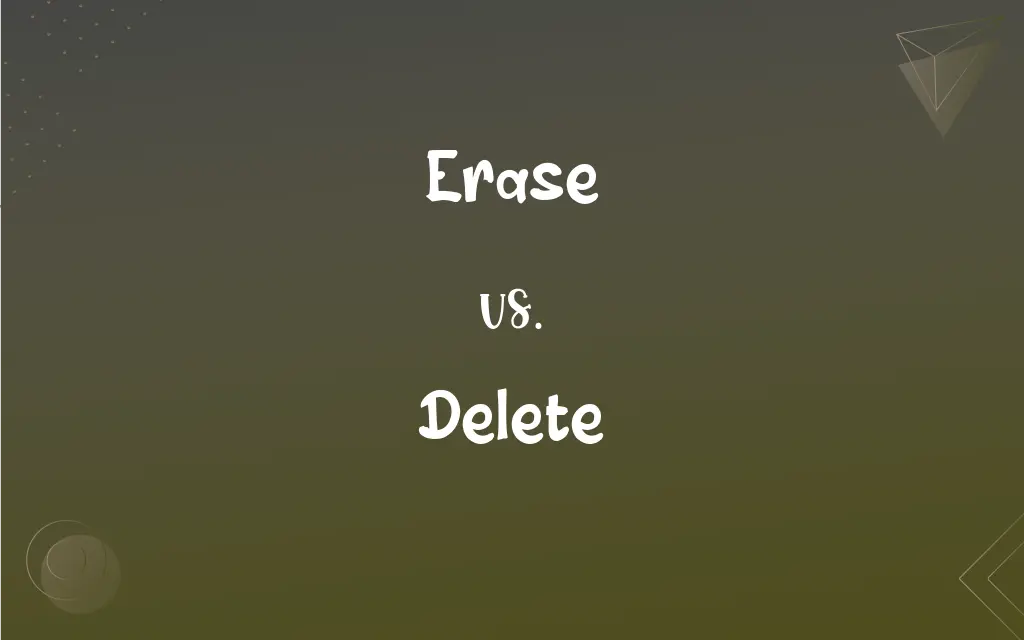Erase vs. Delete: What's the Difference?
By Harlon Moss & Janet White || Updated on May 22, 2024
Erase refers to removing written or drawn marks, often on physical surfaces, while delete refers to removing digital content or text. Both imply removal but in different contexts.

Key Differences
Erase involves removing physical marks from a surface. It is commonly used when talking about erasing pencil marks on paper or chalk on a chalkboard. This term evokes the idea of manually wiping or scraping off something to restore a clean surface. Delete, on the other hand, pertains to removing digital information. In computing and digital contexts, deleting means removing files, text, or data from a digital device or application. This action typically results in the content being moved to a trash or recycle bin, where it can sometimes be restored.
Erase is often associated with temporary, reversible actions. For example, pencil marks can be erased and rewritten multiple times. However, when something is erased thoroughly, it might leave faint traces or marks behind, indicating it was once there.
Delete generally implies a more permanent removal. Deleted digital content, while sometimes recoverable from trash bins, is usually considered gone from its original location. Permanent deletion typically means the data is not easily recoverable without specialized software.
In educational settings, erase is frequently used in classrooms where students erase mistakes from their notebooks or teachers erase the board. Delete is more relevant in technological and office environments, where users delete emails, documents, or lines of code.
Erase refers to removing physical marks, often reversible and seen in traditional contexts, while delete refers to digital content removal, generally more permanent and in tech-related contexts.
ADVERTISEMENT
Comparison Chart
Context
Physical, traditional
Digital, technological
Reversibility
Often reversible
Generally permanent
Common Usage
Notebooks, chalkboards
Computers, digital devices
Action Type
Manual wiping or scraping
Digital command or function
Residue/Traces
May leave faint traces
Typically leaves no traces
ADVERTISEMENT
Erase and Delete Definitions
Erase
To remove marks from a surface.
She used an eraser to erase the pencil drawing.
Delete
To remove or obliterate.
The editor deleted the unnecessary paragraphs.
Erase
To remove from memory or existence.
He wished he could erase the bad memories.
Delete
To erase text or data from a computer.
She deleted the old files from her laptop.
Erase
To rub out written or printed matter.
She carefully erased the error in her notes.
Delete
To cancel or remove something.
The user deleted his social media account.
Erase
To remove (something written, for example) by rubbing, wiping, or scraping.
Delete
To cancel, strike out, or make impossible to be perceived
Deleted the expletives from the transcript with a marker.
Erase
To remove (recorded material) from a magnetic tape or other storage medium
Erased a file from the hard drive.
Delete
To remove from a document or record
Deleted the names from the computer file.
Erase
To remove recorded material from (a magnetic tape or disk, for example)
Erased the DVD.
Delete
To remove (a file, for example) from a hard drive or other storage medium.
Erase
To remove all traces of; eliminate or obliterate
Had to erase all thoughts of failure from his mind.
Delete
To remove, get rid of or erase, especially written or printed material, or data on a computer or other device.
Erase
(transitive) to remove markings or information
I erased that note because it was wrong.
Delete
To defeat or dominate.
Erase
(transitive) To obliterate information from (a storage medium), such as to clear or (with magnetic storage) to demagnetize.
I'm going to erase this tape.
Delete
To kill or murder.
Erase
(transitive) To obliterate (information) from a storage medium, such as to clear or to overwrite.
I'm going to erase those files.
Delete
(computing) A deletion.
Erase
To remove a runner from the bases via a double play or pick off play
Jones was erased by a 6-4-3 double play.
Delete
(recorded entertainment industry) A remainder of a music or video release.
Erase
(intransitive) To be erased have markings removed, have information removed, or be cleared of information.
The chalkboard erased easily.
The files will erase quickly.
Delete
(uncountable) Delete
Erase
(transitive) To disregard (a group, an orientation, etc.); to prevent from having an active role in society.
Delete
(computing) The delete character (U+007F or %7F).
Erase
To kill; assassinate.
Delete
To blot out; to erase; to expunge; to dele; to omit.
I have, therefore, . . . inserted eleven stanzas which do not appear in Sir Walter Scott's version, and have deleted eight.
Erase
(computing) The operation of deleting data.
Delete
Remove or make invisible;
Please delete my name from your list
Erase
To rub or scrape out, as letters or characters written, engraved, or painted; to efface; to expunge; to cross out; as, to erase a word or a name.
Delete
Wipe out magnetically recorded information
Erase
Fig.: To obliterate; to expunge; to blot out; - used of ideas in the mind or memory.
Delete
Cut or eliminate;
She edited the juiciest scenes
Erase
Remove from memory or existence;
The Turks erased the Armenians in 1915
Delete
To remove digital content.
He accidentally deleted the important email.
Erase
Remove by or as if by rubbing or erasing;
Please erase the formula on the blackboard--it is wrong!
Delete
To remove an item from a list or record.
He deleted the duplicate entry from the spreadsheet.
Erase
Wipe out magnetically recorded information
Erase
To wipe out completely.
The teacher erased the board after the lesson.
Erase
To eliminate completely.
The program aimed to erase poverty in the community.
FAQs
Can erased marks be recovered?
Sometimes faint traces of erased marks remain and can be partially recovered, especially with special techniques.
Is erasing the same as deleting?
No, erasing typically refers to physical removal of marks, while deleting refers to digital removal of data.
What tools are used to erase?
Common tools include erasers, cloths, and solvents, depending on the surface and material.
Is deleting reversible?
Deleting can be reversible if the content is in a recoverable state, such as in a recycle bin, but permanent deletion is not easily reversible.
What tools are used to delete?
Deleting is done using digital commands or functions, such as pressing the delete key or using software options.
What does it mean to erase something?
To erase means to remove marks or writings from a physical surface, often using an eraser.
What does it mean to delete something?
To delete means to remove digital content, such as files, emails, or text, from a device or system.
Does deleting leave traces?
Deleted digital content generally does not leave traces unless it's recoverable through system logs or backups.
Can deleted files be recovered?
Deleted files can often be recovered from a recycle bin or with specialized software, unless they are permanently deleted.
Does erasing leave residue?
Erasing can leave faint traces or residue on the surface.
Is erasing a manual process?
Yes, erasing is usually a manual, physical process.
Where is erasing commonly used?
Erasing is common in educational and artistic settings, such as schools and studios.
Can erasing be done repeatedly?
Yes, surfaces can be erased and re-used multiple times.
Can deleting be done repeatedly?
Yes, digital content can be deleted and recreated multiple times.
Is erasing reversible?
Erasing can often be reversible to an extent, with faint traces sometimes remaining.
Is deleting a manual process?
Deleting can be both manual, by user action, or automatic, by software commands.
What materials are typically deleted?
Commonly deleted materials include digital files, emails, text, and data.
Where is deleting commonly used?
Deleting is common in technological and office settings, such as with computers and digital devices.
How does erasing differ from other removal methods?
Erasing specifically involves removing marks from a surface, often manually, while other removal methods might involve cutting, covering, or altering.
What materials are typically erased?
Commonly erased materials include pencil marks, chalk, ink, and other surface markings.
About Author
Written by
Harlon MossHarlon is a seasoned quality moderator and accomplished content writer for Difference Wiki. An alumnus of the prestigious University of California, he earned his degree in Computer Science. Leveraging his academic background, Harlon brings a meticulous and informed perspective to his work, ensuring content accuracy and excellence.
Co-written by
Janet WhiteJanet White has been an esteemed writer and blogger for Difference Wiki. Holding a Master's degree in Science and Medical Journalism from the prestigious Boston University, she has consistently demonstrated her expertise and passion for her field. When she's not immersed in her work, Janet relishes her time exercising, delving into a good book, and cherishing moments with friends and family.































































